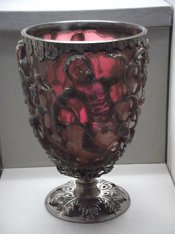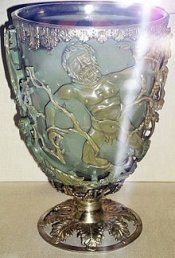Mustafa Umut Sarac
Member
The alchemists in the seventeenth century used the nano particles to create the beautiful colors of the windows of Santa Maria Novella in Florence or the Notre Dame of Paris: by the dispersion of gold nano crystals of various sizes, brilliant ruby red (70 nm) or yellow gold (100 nm) can indeed be achieved.
Thus, nano technological colors, not molecular colors, but the principle is the same: what determines the color is the radiation-matter
interaction which causes the absorption of certain wavelengths and the reflected of others.
But before that, in the fourth century AD, the unusual color of the Lycurgus vase


The dichroic effect is achieved by making the glass with tiny proportions of minutely ground gold and silver dust. To a conventionally composed Roman glass flux 330 parts per million of silver and 40 of gold were added: "These particles were precipitated as colloids and form a silver-gold alloy. When viewed in reflected light the minute metallic particles are just coarse enough to reflect enough of the light without eliminating the transmission. In transmitted light the fine particles scatter the blue end of the spectrum more effectively than the red end, resulting in red transmission, and this is the colour observed. Since it is impossible that the Roman artisans managed to add these incredibly low levels of silver and gold to the volume of the glass used to make the vessel deliberately, the levels were probably added at higher levels to a larger volume of glass-melt, and increasingly diluted by adding more glass."[7] The particles are only about 70 nanometers across, and embedded in the glass, so they cannot be seen by optical microscopy, and a transmission electron microscope is needed instead.[8] At this size they approach the size of the wavelengths of visible light, and a surface plasmon resonance effect takes place.[9]
is linked to the
formation of gold and silver particles sized 70 nm: the vase looks green when viewed in reflection,
red when viewed in transmission (for the same reason why the sky appears blue and the setting sun
appears red).
The same phenomenon, was exploited in the Renaissance period to produce the golden and red
colours of the Gubbio and Deruta (Italy) lusters
http://www.thatsarte.com/0/history-and-tradition
I think nanoparticles could be used as colorants in many ways
Mustafa Umut Sarac
Istanbul
Thus, nano technological colors, not molecular colors, but the principle is the same: what determines the color is the radiation-matter
interaction which causes the absorption of certain wavelengths and the reflected of others.
But before that, in the fourth century AD, the unusual color of the Lycurgus vase


The dichroic effect is achieved by making the glass with tiny proportions of minutely ground gold and silver dust. To a conventionally composed Roman glass flux 330 parts per million of silver and 40 of gold were added: "These particles were precipitated as colloids and form a silver-gold alloy. When viewed in reflected light the minute metallic particles are just coarse enough to reflect enough of the light without eliminating the transmission. In transmitted light the fine particles scatter the blue end of the spectrum more effectively than the red end, resulting in red transmission, and this is the colour observed. Since it is impossible that the Roman artisans managed to add these incredibly low levels of silver and gold to the volume of the glass used to make the vessel deliberately, the levels were probably added at higher levels to a larger volume of glass-melt, and increasingly diluted by adding more glass."[7] The particles are only about 70 nanometers across, and embedded in the glass, so they cannot be seen by optical microscopy, and a transmission electron microscope is needed instead.[8] At this size they approach the size of the wavelengths of visible light, and a surface plasmon resonance effect takes place.[9]
is linked to the
formation of gold and silver particles sized 70 nm: the vase looks green when viewed in reflection,
red when viewed in transmission (for the same reason why the sky appears blue and the setting sun
appears red).
The same phenomenon, was exploited in the Renaissance period to produce the golden and red
colours of the Gubbio and Deruta (Italy) lusters
http://www.thatsarte.com/0/history-and-tradition
I think nanoparticles could be used as colorants in many ways
Mustafa Umut Sarac
Istanbul










